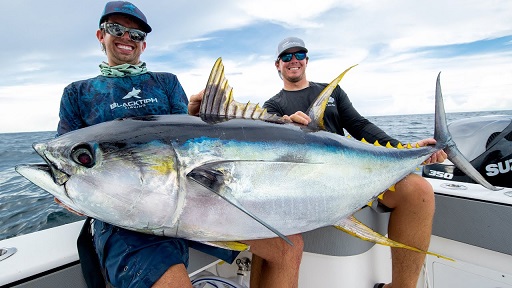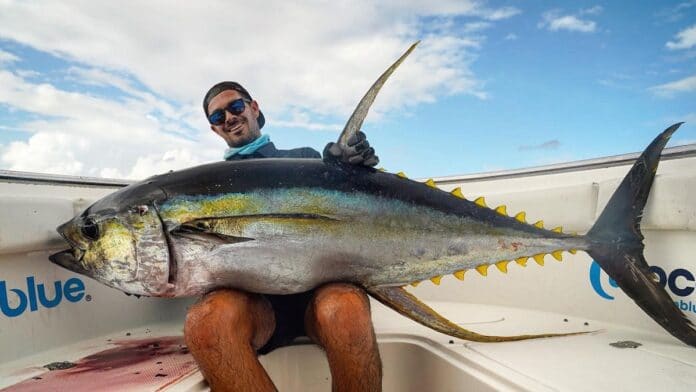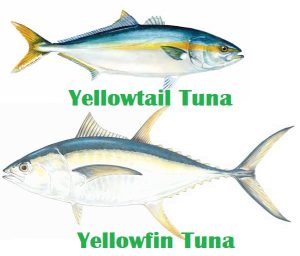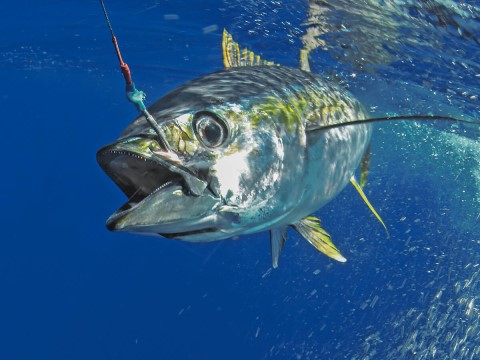How to Catch Yellowfin Tuna
Yellowfin tuna have the potential of reaching up to a weight of 400lbs or 180kg. This makes them super strong fighters, and they pull extremely hard. Yellowfin are a great gamefish and a pleasure to catch. As a bonus, they are also great to eat! They are mainly found in the warmer offshore waters.
Read more about the Yellowfin Tuna species.
Yellowfin Tuna Tackle
Do some research into the area you are fishing in. Match your tackle to the size of tuna expected. Some schools have yellowfin tuna in the 5kg or 10lb size, others areas contain much larger tuna.
Calstar rods are a good product for all tuna. Shimano Trinidad 16 reel will work for a variety of fish sizes. A recommendation for the big yellowfin tuna is an Accurate Platinum ATD 50
Check out our links below for prices.
Yellowfin Tuna Catching Techniques
Yellowfin Tuna can be caught with bait and lures. There are many techniques and it’s good to be familiar with them, fish can be tricky to catch some days.
The easiest way to catch yellowfin tuna is when they are breaking the surface feeding. They usually in a feeding frenzy and throwing your lure amongst the bait fish is sure to produce results. Spot the tuna schools by looking into the sky and seeing where birds are flocking, they are usually above the schools picking off baitfish also. When the water’s surface is breaking with activity, tuna are feeding. Get your boat as close to the school and throw your lures into the feed zone.
Trolling is a tried and traditional technique for tuna. Visit this post for detailed Tuna Trolling Info
Another techniques is to lure the yellowfin to you. Whether you are fishing with lures or bait, chum is effective on tuna of all sorts, and Yellowfin are no exception. You can either chum with live bait or chunks of cut bait. That helps keep the fish around the boat.
Check out chumming techniques.
Lures for Catching Yellowfin Tuna
Regardless of the technique you employ, try using tuna specific lures. Feather lures, cedar plugs, poppers and plastic skirted lures have the best results. If the fish are deep and under the bait schools, metal jigs will work. In general the quick retrieving lures work best with tuna since they have good eyesight.
It is recommended to buy a reputable lure brand. These lure will swim faster and more accurately mimicking bait fish. It Is really important to have a good variety of lure sizes and types, they need to match the baitfish in the water. Natural colours work best, blue, silver, green, etc.
Top lure brands include Rapala, Halco Max, Yo-Zuri Sashimi Bull, Shimano Orca.
Click on the links below to purchase some great Yellowfin Tuna lures:
How to Catch Yellowfin Tuna with Bait
As with lures, you need to select the bait that the tuna are feeding on in your area. For smaller tuna sizes Anchovies, sardines and squid work well. Pacific Mackerel and even small skipjack tuna work for catching larger yellowfin.
If you do not have live bait chunking is an option. This entails cutting chunks of a large bait fish (perhaps a Skipjack) and then tossing them over the side. In one of the chunks hide a circle hook and let it drift down naturally with the rest of the chunks. Make sure you let out a lot of line so that the chunk can drift without any drag. If something picks it up it will take off and you will know right away. Tuna don’t nibble.
Check out other species of tuna.

 Shimano Trinidad Reels
Shimano Trinidad Reels Fishing Reels
Fishing Reels Braided Fishing Line
Braided Fishing Line Cedar Plugs Tuna Fishing Lures
Cedar Plugs Tuna Fishing Lures Blue Fly Fish Saltwater Trolling Fishing Lures
Blue Fly Fish Saltwater Trolling Fishing Lures Saltwater Trolling Lure for Tuna
Saltwater Trolling Lure for Tuna Stainless Steel Fishing Leaders
Stainless Steel Fishing Leaders Fishing Rod Holder
Fishing Rod Holder Lures Bait Rig Or Hooks
Lures Bait Rig Or Hooks


 Penn Tuna Fishing Rod & Reel Combo
Penn Tuna Fishing Rod & Reel Combo View Best Tuna Fishing Lures
View Best Tuna Fishing Lures